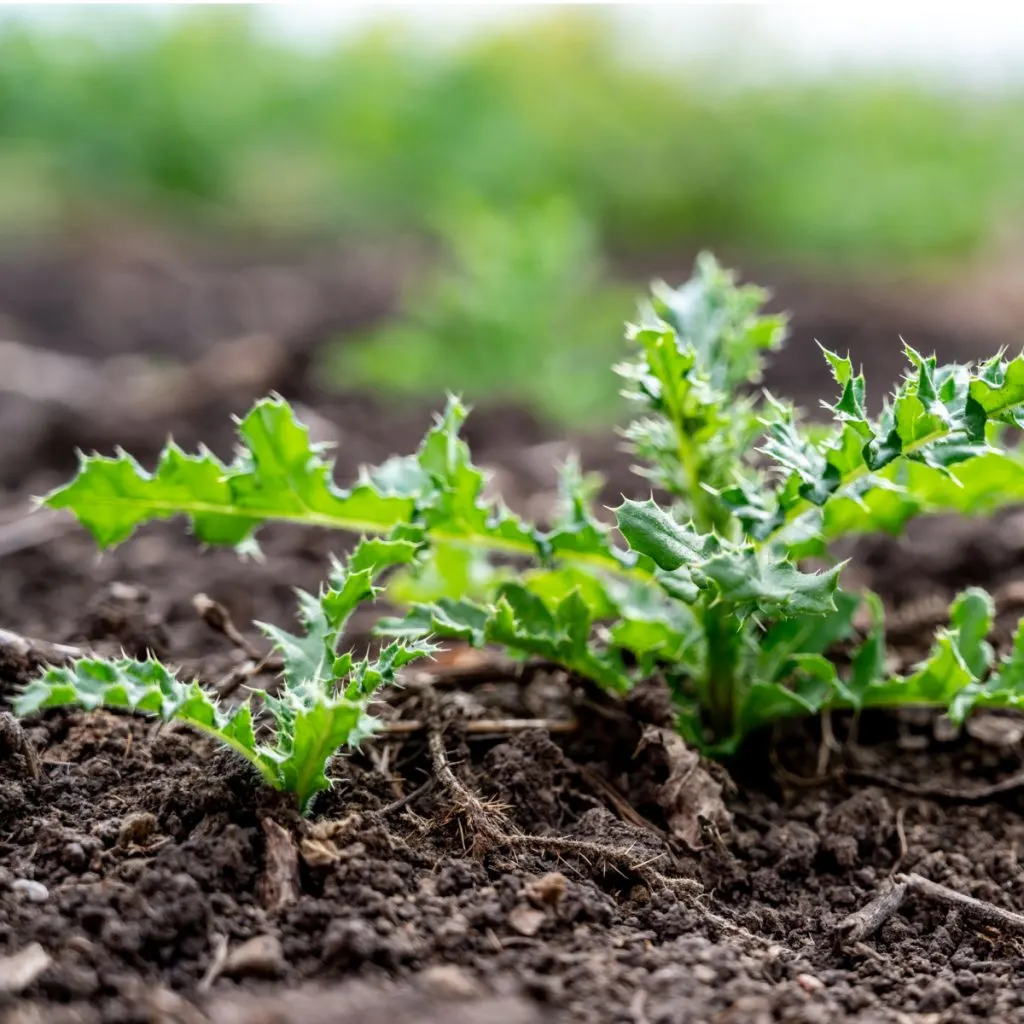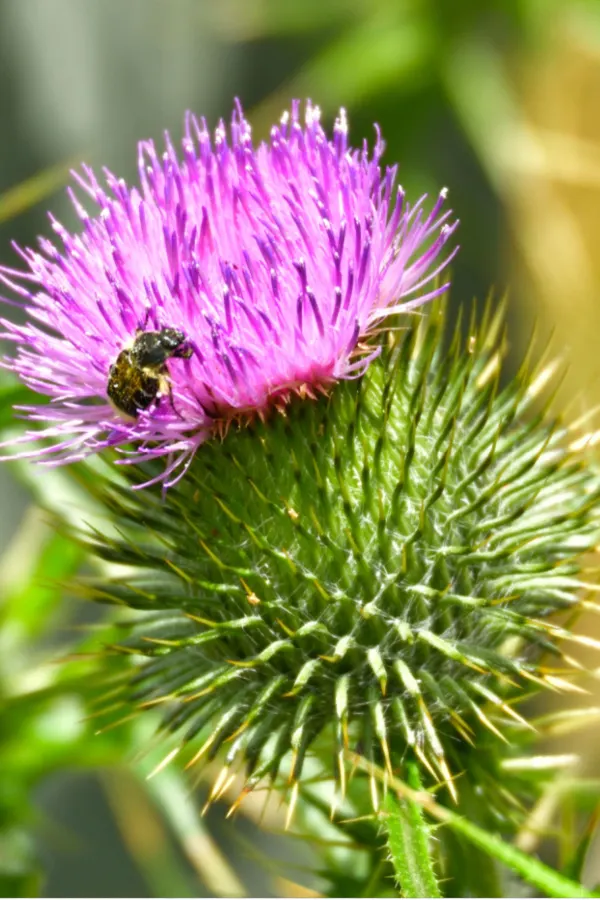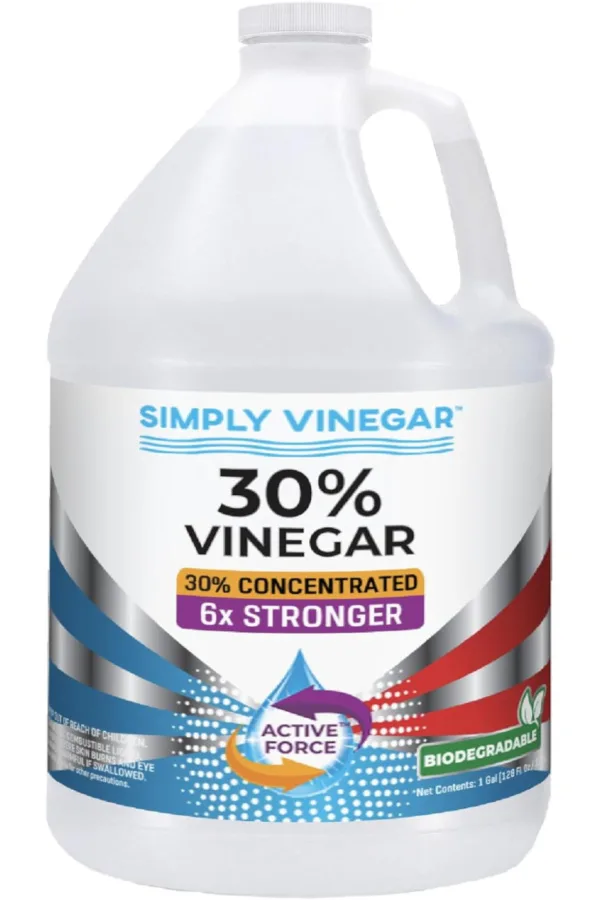Looking for an easy way to get rid of thistles in your flowerbeds and gardens? And one that keeps them from coming back time and time again?
If you’ve been struggling with thistles popping up in your garden, flowerbeds, or even across your lawn, you’re not alone. Thistles are one of the most stubborn and frustrating weeds a gardener can deal with. Once they find a way into your soil, they don’t go away easily.
What makes them even harder to deal with is that pulling them up by hand rarely works. In fact, it often makes the problem worse. But here’s the good news: there’s a simple, natural way to get rid of thistles – and keep them from coming back for good.

With the right approach, you can thistles out without relying on harsh chemicals, and without damaging your soil or hurting nearby plants. The method is easy, effective, and something every gardener can do with ease. All by using vinegar!
A Simple Way To Get Rid Of Thistles In Flowerbeds & Gardens
Why Thistles Are So Hard To Kill
Thistles don’t act like most other weeds. What makes them such a problem is their strong and deep taproot. This taproot can grow straight down into the soil several feet deep. Even if you manage to pull out the top of the plant, chances are you’ve left part of that root behind. And as long as any piece of that root remains, the plant will simply grow back.
It doesn’t take long for thistles to spread, especially when they’re left to grow. One mature thistle can produce thousands of tiny seeds. And those seeds float around with the slightest of breezes, spreading not just across your garden, but into your flowerbeds and lawn.
Before you know it, you’re dealing with dozens or even hundreds of thistles all over again. And the worst part? When you start pulling or disturbing thistle plants, it often triggers even more growth. That’s because underground roots may already have small shoots ready to sprout. Dig too aggressively, and you risk making the problem worse instead of better.

The Secret Weapon – Horticultural Vinegar
The answer to thistle lies in a simple product that’s natural but powerful – horticultural vinegar. This is not the same vinegar you cook with in the kitchen. While household vinegar usually contains about 5% acidity, horticultural vinegar is much stronger. It often comes in strengths of 20%, 30% or higher.
The higher concentration makes it strong enough to kill even the toughest weeds – including deep-rooted thistles. But to work properly, you need to use it the right way.
Spraying the leaves of a thistle might seem like a quick solution, but that only kills the top part of the plant. The root below the surface can still live on and grow back. That’s why a little more care is needed if you want to stop thistles from returning.
A Simple Two-Step Method To Kill Thistles For Good
There’s a surprisingly simple two-step trick that works incredibly well at getting rid of thistles. Not only does it stop the plant in its tracks, it also helps kill the root below and keeps it from growing back.
Step One: Cut the Plant Low
Using a sharp pair of garden scissors or pruning shears, cut the thistle plant down as close to the ground as possible—about one to two inches above the soil line. Don’t try to dig it up or pull it out. Just give it a clean snip across the stem.
Why is this important? When a thistle is cut, it goes into repair mode. It starts pulling water and nutrients from the root to heal the cut stem. And that’s when step two comes into play.
Step Two: Apply Higher Strength Vinegar Directly
Right after cutting the stem, use a small spray bottle or dropper to apply horticultural vinegar directly to the cut surface. Using a vinegar with at least a 30% acidity is perfect to do the job. Affiliate Link: 30% Vinegar – Pure Concentrated Active-Force Vinegar
This fresh wound acts like an open door, allowing the vinegar to be absorbed deep into the plant’s system. It will travel down to the taproot – and kill it off in the process. Be sure to also spray any remaining leaves that might still be attached, but be careful not to let the vinegar touch other nearby plants. This solution doesn’t just kill weeds – it kills any foliage it touches.
Why This Method Works So Well To Get Rid Of Thistles
The reason this method is so successful is because of how plants respond to injury. When a plant like thistle is cut, it tries to heal by pulling in energy and moisture from the root system. But when you introduce vinegar at the moment of injury, it takes in the acid instead.
Once inside the plant, the vinegar burns its way through the inner cells. This process destroys the plant from within and shuts down the taproot’s ability to keep sending up new growth.
If you only spray the leaves of a thistle, the top part of the plant may die – but the taproot likely survives. That’s why many gardeners see weeds come right back again and again after using regular vinegar sprays. The cut-and-spray method ensures that the plant takes in the vinegar and allows you to get rid of thistles for good.

Using Vinegar Safely In The Garden
Even though horticultural vinegar is natural, it’s still a strong acid. When handling it, always wear gloves and eye protection. Avoid using it on windy days, as even a small breeze can carry the spray to nearby flowers or vegetables and cause damage.
Also, never pour vinegar directly into the soil or over a wide area. While a little splash here or there isn’t usually harmful, overdoing it can change the pH of the soil. This can make it harder to grow plants in that spot for months to come.
To avoid waste and damage, use an eyedropper or very small spray bottle. This helps you be precise with where the vinegar lands – and ensures it goes only where you want it.
Be Patient – But Persistent
If your garden is full of thistles, don’t be discouraged if you don’t eliminate them all in one day. Thistles often grow in clusters, but many times those clusters are part of a main root system. Once you remove those big root bases, the rest usually fade away quickly.
It may take a few days or even a couple of weeks of treating cut thistles before you stop seeing new ones pop up. But stay with it. As you cut and treat each one, you are breaking down their underground network and cutting off their ability to grow back.
The best part? You’re getting rid of thistles without damaging your garden soil – or using chemicals that could harm other plants, pets, or people!
Industrial strength vinegar is also great for keeping weeds clear from driveways, patios and walkways. For more on that, check out our article: How To Get Rid Of Weeds With Horticultural Vinegar.
This Is My Garden
Follow Our Facebook Page For Great Gardening Tips And Advice! This Is My Garden Facebook Page
This Is My Garden is a garden website created by gardeners, for gardeners. Jim and Mary Competti have been writing gardening, DIY and recipe articles and books and speaking for over 15 years from their 46 acre Ohio farm. They publish three articles every week, 52 weeks a year. Sign up today to follow via email, or follow along!

